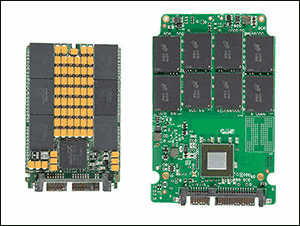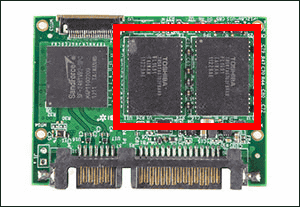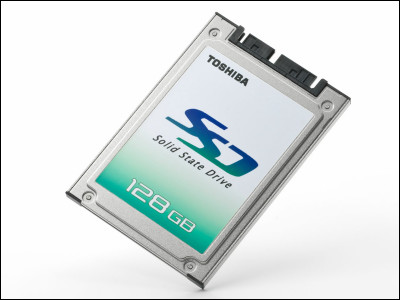Form factor (shape / standard) that can easily understand "SSD" Summary

BySamsungTomorrow
longstorageSpeaking of the leading roleHard disk drive (HDD)However, in recent years,SSD (solid state drive)It is stealing that seat. It is a SSD which is rapidly spreading with the performance to overwhelm HDD, but since it is still in transition period, standards such as size, shape and terminals are various. To make it easier to understand SSD which seems to be difficult somewhatForm factorHere is the summary of classifying SSDs.
SSD Form Factors: Everything You Need to Know - TechSpot
http://www.techspot.com/guides/768-ssd-form-factors/

◆size
SSD appeared mainly as a substitute for HDD of notebook PC. The picture below is the SSD when it began to be mounted on the notebook PC, it is not in the caseCircuit BoardThe memory chip and controller on above was exposed. A hard disk is also adopted as the connector of this early stage SSDSATAHas been adopted. The substitute SSD (right) of the 2.5 inch HDD is a general SATA connector, whereas the substitute SSD (left) of the 1.8 inch HDD is smallerMicro SATAConnector is adopted.

Among the components of the SSD, the memory chip occupies the largest area. The form factor (shape standard) such as the arrangement of the memory chip and the connector and the substrate size isJEDEC (Joint Electronic Device Engineering Council)Since standards have been formulated by the manufacturer, SSD manufacturers are making products according to JEDEC standards. Since the size of the SSD is changed according to the mounting amount of the memory chip, when a large amount of memory chip is mounted with a large capacity SSD, a large board may be used.
Photo red frame is a memory chip.

The SATA connection type SSD is smaller in size than a typical 3.5 inch HDD. Many notebook PCs and modern desktop PCs have a 2.5 inch size SSD. This stems from the circumstances of SSD's popularization that it was often used to replace 2.5 inch HDD.

ByYutaka Tsutano
But like a photoPCIeConnecting using, the higher speed and high performance SSD is a relatively large size. PCIe is a connector used for inserting graphic boards, so some PCIe high-performance SSDs have sizes as large as graphic boards.

Besides, SSD of a special order model tailored to the product can also be seen in part. This is because the SSD is composed of small parts called memory chips and controllers, and its size and shape can be freely designed. Compared to the HDD that requires platter and head, the SSD can be designed with high degree of freedom.

◆connector
In order to install the SSD in the computer, you can not use the SSD unless you select the connector that suits the computer. Therefore, the specification of the SSD interface connector (connection terminal) is the most important form factor.
Initial SSD adopted SATA connector (bottom photo) of the same shape as HDD, but it has evolved to its own shape (on the photo) so that it can be mounted on a smaller PC.

The picture below is common for current notebook PCs and small mobile terminalsMSATA (Mini SATA)Connector called. On the left of the photo is mSATA of standard size (vertical 5.08 cm × width 2.99 cm), the right is a model customized to be able to mount many memory chips. It is perfectly small and thin parts to call mSATA SSD "card".

MSATA is widely adopted in notebook PCMin PCI Express slotIt is a standard for attaching to not only notebook PCNUCSome desktop PCs are also adopted such as. Please note that Micro SATA and mSATA which are often used in SSD of 1.8 inch size mentioned above are very similar names, but they are totally different things.
Although many SSDs used for mobile terminals are mSATA connector models, a new standard "NGFF (Next Generation Form Factor)" aiming at further downsizing and thinning was proposed by Intel in 2012, "M.2"And it is born as an official standard. M.2 supports both SATA and PCIe, and various SSD sizes have been formulated, and it is expected that it will become popular in the future replacing mSATA.

In addition, the manufacturer also has its own model on the connector. For example, in Apple's MacBook Air SSDs are adopted for all models, but their shapes are slightly different. Apple adopted the original connector rather than a general JEDEC compliant connector, it was SATA from 2010 to 2012, but in 2013 it is switching to PCIe for further speeding up is.

Furthermore, in the SSD there areUSBAppeared to adopt the standard adopted. SSD is getting more and more familiar.

SSD, which has an extremely high unit cost price compared to HDD, was initially adopted only for high-performance PCs, but due to its overwhelming high performance, SSD has been rapidly spreading, As a result of the virtuous circle of decreasing rapidly, it is becoming a part that can be easily introduced now. In the future, if the unit price of capacity further decreases, the day when SSD replaces all HDDs may come.
Related Posts:







